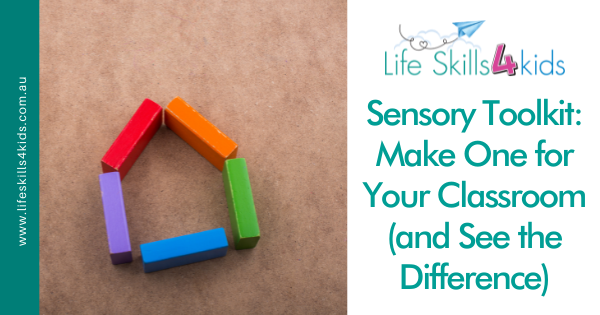Any teacher of a student with special sensory needs knows that things just aren’t the same in the classroom. You seem to spend more time managing behaviour than before and it eats up your valuable teaching time. It’s frustrating. You’re probably also wondering if there is an easier way to deal with kids with sensory issues. But what if a sensory toolkit could help these students to be more focused and settled? That would be worth the effort to put one together, right?
What is a Sensory Toolkit (and how does It Work in the Classroom)?
A sensory toolkit for the classroom one of a teacher’s best classroom management strategies for children with special sensory needs. It helps to provide the stimulation or calming that they need to focus, learn, and behave. A sensory toolkit consists of a group of sensory items gathered into one collection and kept in the classroom where it is accessible for immediate use. It also includes plans or strategies that form part of a teacher’s classroom management techniques.
Focus on these 7 Areas of Sensory Input
Our bodies process sensory input through 8 different areas of the body. Children with special sensory needs don’t process this input in the same way everyone else does and a sensory toolkit aims to help them to compensate by meeting their individual requirements. A sensory toolkit should aim to address the following areas of sensory need:
- Auditory (sound)
- Olfactory (smell)
- Tactile (touch)
- Vestibular (movement)
- Gustatory (taste/mouth input)
- Proprioception (muscle input)
Items to Include for Maximum Benefit
Not every child with sensory processing issues will use every item in your sensory toolkit. You will probably find that you add to it over time as you find things that work for some children but not others. But for a start, consider adding the following items:
-
An item that spins
Some children respond well to being able to spin around to increase proprioception and vestibular input. Suitable items could be a Bilibo seat, a sit-and-spin disc, or go all-out on a permanent hanging pod swing in a corner of the classroom.
-
A scooter board
While this may not be suitable for every classroom environment, a four-wheeled scooter board is perfect for some students to use during sensory breaks as it provides movement and muscle stimulation.
-
Chewy sensory toys for oral input
Some children require oral stimulation or oral activities to calm. For calming, try individual chewy toys such as bracelets or pendants or chewable pencil toppers. Some children need the stimulation of making noises with their mouths or blowing bubbles. Crunchy food textures are also frequent winners. For oral sensory tools to calm instead of stimulating, add balloons or whistles to blow during sensory breaks.
-
Sensory toys for fidgeting
The fidget toy craze came and went but it is more than just a fad for kids with sensory problems. Add fidget toys to your sensory toolkit for those that need tactile stimulation. Fidget toys keep hands occupied with pushing, pulling, spinning, squeezing or clicking and are among the useful sensory tools for anxiety.
-
Music and sound tools
During sensory breaks, certain types of music can be useful to get the class moving and motivated. Music that makes kids want to jump, hop, twirl or dance is great for the kids that need extra muscle or movement input. Alternatively, also have some quieter music handy for when kids need to calm down or move more slowly.
Don’t forget to add some noise-cancelling headphones for the times that some kids need a break from classroom noise.
-
Vibration
Add a vibrating massager or vibrating toys to your sensory toolkit for kids that need deep touch proprioceptive input. This works well with kids that are old enough to do it for themselves, giving them a sense of control.
-
Body Sock
A lycra body sock can provide several types of sensory input. It is useful when a child is overstimulated and wants to crawl inside for some quiet time. It is also helpful to kids that need muscle or movement input as they push against the stretchy walls inside the tube.
Turn Your Classroom into a Super Sensory Zone
Get your kids excited about learning by implementing fun sensory strategies that make them want to come to school. Your sensory toolkit will be a treasure trove of engaging items that make the classroom a desirable place to be and you will reap the rewards through improved behaviour. If you would like to get in touch and tell us what works for you, we love feedback!

